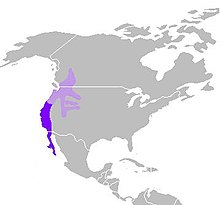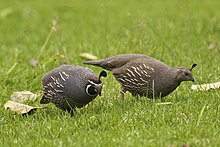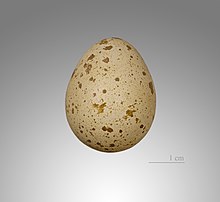Crested quail
| Crested quail | ||||||||||||
|---|---|---|---|---|---|---|---|---|---|---|---|---|

Crested quail ( Callipepla californica ) |
||||||||||||
| Systematics | ||||||||||||
|
||||||||||||
| Scientific name | ||||||||||||
| Callipepla californica | ||||||||||||
| ( Shaw , 1798) |
The crested quail ( Callipepla californica ), also called California crested quail , is a species of the toothed quail family . There are four subspecies that are differentiated based on the color of the upper side of the body. They owe their name to the feather bonnet, which occurs in both sexes.
description
Crested quail reach a body length of 23 to 25 centimeters. Males and females are similarly colored, but the plumage of the females is somewhat more dull, the male also has a black epiglottis and a face ornament. The top of the body and the head are gray-brown. The head has white feather tips. The neck and chest are blue-gray. The brownish flanks have elongated narrow white stripes. The belly and the underside of the tail are yellow-brown with black scales.
Young birds are similar to the adult birds, but they are still missing the conspicuous black scale markings on the belly. The head is shorter and the white feather tips are missing.
Distribution area and habitat
Their distribution area includes the North American west coast. It is also naturalized as a neozoon in Hawaii , New Zealand , Chile and Argentina .
The habitat of the crested quail are arid grasslands and bushy terrain from sea level to altitudes of 2,450 meters. The species prefers regions where bushes reach a height of between one and seven meters. Landscapes that are strongly shaped by humans are also used if they are sufficiently close to water sources. The crested quail is predominantly a resident bird. Small flocks, typically comprised of between ten and forty birds, usually inhabit winter quarters between 9.6 and 33.6 hectares in size.
Way of life
Crested quail mainly eat grass and herb seeds and, to a lesser extent, tree seeds and fruits. Adult birds also eat small arthropods to a small extent .
Crested quail mostly stay on the ground, but sleep in trees. They are ground-brooders who hide their nests in ground hollows and pad them with leaves and stalks. The breeding season is relatively late and falls between June and September. It is believed that crested quail breed so late because the food supply increases with the rains in late summer and early autumn. The female lays between 10 and 17 eggs. The incubation period is 22 to 23 days. The young birds grow up very quickly and reach the size of an adult crested quail at 77 to 105 days of life.
Quail and human
The crested quail is an important game bird in the southwestern United States of America . Since the 1960s, the population there has declined significantly, but this is mainly attributed to a change in the habitat. In the range in Mexico the species is still relatively common and has benefited from the conversion of forests into pastureland. The crested quail is the state bird of California .
Crested quail are very popular as an ornamental bird . They can be kept very well in aviaries together with tree-dwelling bird species. However, it is not recommended to keep them together with other chicken birds .
Subspecies
There are five known subspecies:
- C. c. brunnescens ( Ridgway , 1884) - This subspecies occurs from southwest Oregon to central California .
- C. c. canfieldae ( van Rossem , 1939) - This subspecies is common in eastern central California.
- C. c. californica ( Shaw , 1798) - The nominate form occurs from eastern Oregon to northwestern Mexico .
- C. c. catalinensis ( Grinnell , 1906) - The range of this subspecies is the Santa Catalina Island .
- C. c. achrustera ( JL Peters , 1923) - This subspecies occurs in central and southern Baja California .
supporting documents
literature
- Steve Madge , Phil McGowan, and Guy M. Kirwan : Pheasants, Partridges and Grouse. A Guide to the Pheasants, Partridges, Quails, Grouse, Guineafowl, Buttonquails and Sandgrouse of the world. Christopher Helm, London 2002, ISBN 0-7136-3966-0 (English).
- George Russell Shaw in George Russell Shaw, Frederick Polydore Nodder: The naturalist's miscellany, or Colored figures of natural objects . tape 9 . Printed for Nodder & Co., London 1798 ( online [accessed April 3, 2015]).
- Robert Ridgway: Description of some new North American Birds . In: Proceedings of The Biological Society of Washington . tape 2 , 1884, p. 89–95 (English, online [accessed April 3, 2015]).
- Joseph Grinnell: The Catalina Island Quail . In: The Auk . tape 23 , no. 3 , 1906, pp. 262–265 (English, online [PDF; 174 kB ; accessed on April 3, 2015]).
- Adriaan Joseph van Rossem: An Overlooked Race of the California Quail . In: The Auk . tape 56 , no. 1 , 1939, p. 68–69 (English, online [PDF; 112 kB ; accessed on April 3, 2015]).
- James Lee Peters: A new Quail from Lower California . In: Proceedings of the New England Zoological Club . tape 8 , 1923, pp. 79–89 (English, online [accessed April 3, 2015]).
Web links
- Callipepla californica in the endangered Red List species the IUCN 2008. Posted by: BirdLife International, 2008. Accessed January 31 of 2009.
- Videos, photos and sound recordings of Callipepla californica in the Internet Bird Collection
Single receipts
- ↑ a b c Madge et al., Pp. 390-391
- ↑ 50states California State Bird . Retrieved December 7, 2010.
- ↑ IOC World Bird List Megapodes, guans, guineas & New World quail
- ^ Robert Ridgway, p. 94.
- ^ Adriaan Joseph van Rossem, p. 68.
- ↑ George Russell Shaw, plate 345 & text.
- ^ Joseph Grinnell, p. 262.
- ↑ James Lee Peters, p. 79.




